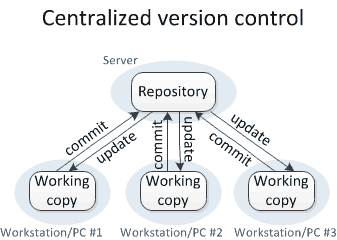December 1 2015
A.K.A: Revision Control, Source Control
The management of changes to documents
- Track Changes across document edits
- Allows a document to be reverted to previous versions
- Preserves history of a document
Below you can see the diff between this file in a previous commit and my current working copy
In my working copy, i've removed lines (in red) and added lines (in green)
Git and SVN are the two VCS programs we use here
Both programs come with a full set of command line tools, though there are many tools to provide a GUI for them
Open source VCS maintained by Apache
- Source
- Windows GUI: Tortoise SVN
- Mac GUI: Versions
Pros:
- Simple, stable, mature software
- Easy to teach and implement for small to large projects
- Fairly linear workflow.
Cons:
- Not well suited for intricate branching, merging
- Harder to handle larger projets with many developers
- Slower, larger repositories
Open source VCS written by Linus Torvalds (creator of Linux)
- Source
- Cross Platform GUI: Source Tree
Pros:
- Emphasis on distributed, non-linear workflows
- Faster than SVN
- "Allows for frictionless context switching, disposable experimentation, and feature based workflow"
Cons:
- Much more complicated to learn
- You can't check out partial repositories (i.e subtrees)
Differences in workflow between SVN and GIt
Adds an extra layer between your working copy and the repository
Sometimes you don't want files to be committed to the repository
You can place a file named .gitignore at any level of a git directory and it can contain file globbing patterns to ignore certain paths
# all files with extension
*.html
# directories
platforms/Its slightly more complicated to ignore files in SVN, unless you use Tortoise.
To ignore from the command line, use the following command in your repository:
$ svn propset svn:ignore "*.jpg" . Glossary of terms to help translate between git and svn
- Repository: Standalone set of version controlled documents
- Revision: Number or hash that identifies a repository state
- Diff: The difference between one copy of a file and another
- Working Copy: Your copy of the repository at any given point in time. This working copy may contain un-commited changes.
- Subtree (git): Subset of a full repository
- External (svn): Reference to file/subtree in another repository
- Clone (git) / Checkout (svn): Download a repository to your local machine
- Commit: Write or merge changes back to repository
- Push (git): Copy your local repository changes up to the server
- Pull (git) / Update (svn): Copy server repository changes to your local copy
- Tag: Refers to an important snapshot in time. Assigns a label to a certain revision
General
- Be very careful when you move documents
Git
- Git only tracks changes to files, not directories
- Sometimes you want to un-ignore a file. You may have to manually add the file with the force flag:
git add -f file.html
SVN
Use a sandbox to explore git and svn
- Clone (checkout) the sandbox
- Commit a change to your local repository
- Branch your local repository
- Commit multiple changes to your branch
- Branch your local repository again
- Commit a change to this branch
- Merge both branches back into the
master - Push your master branch back up to the server repository



